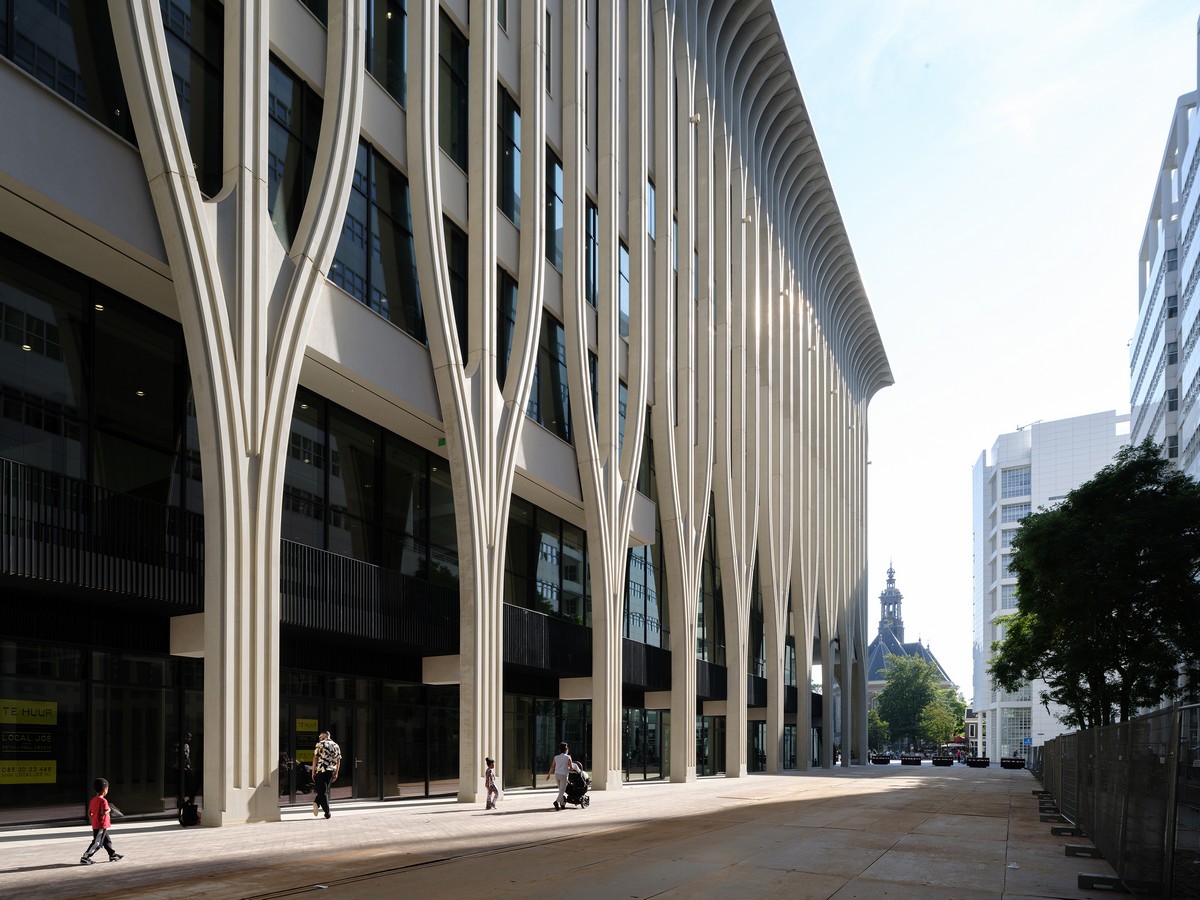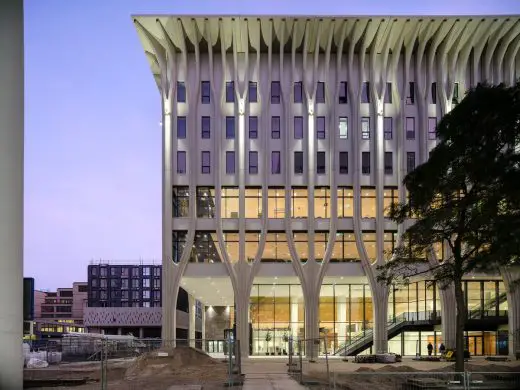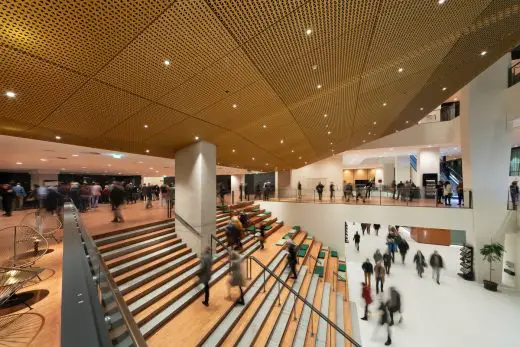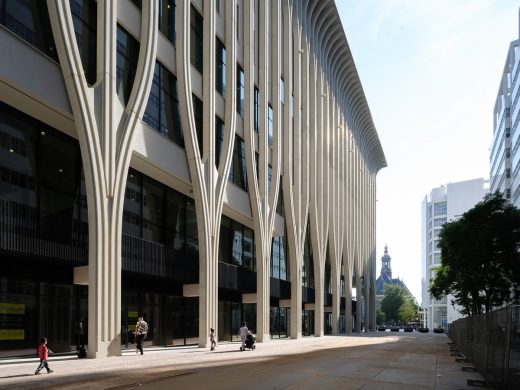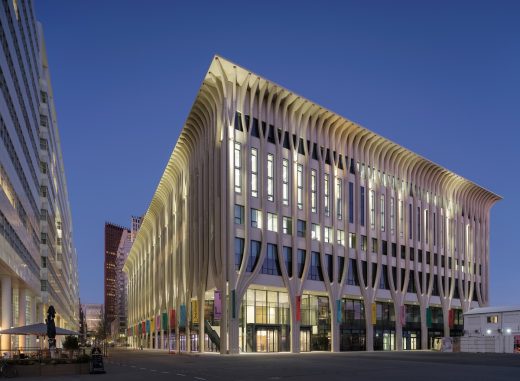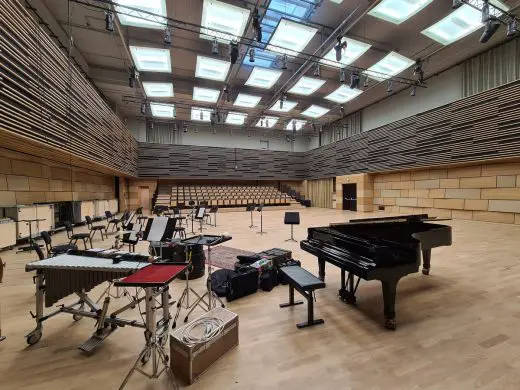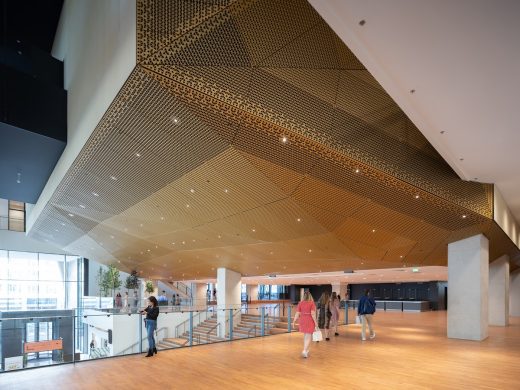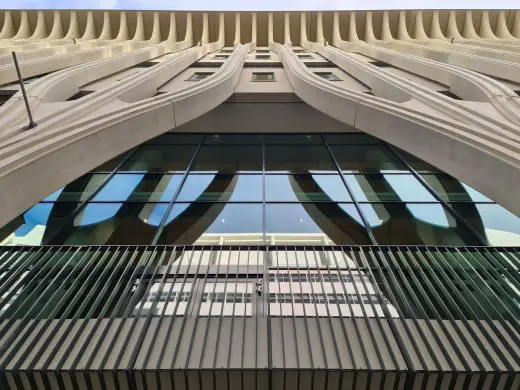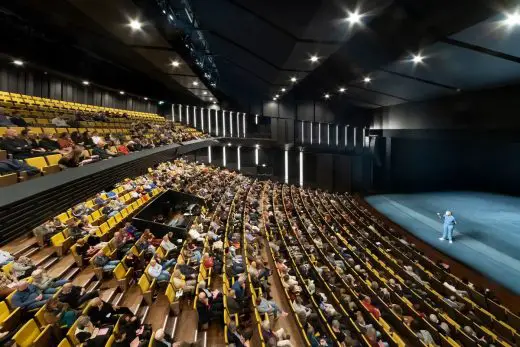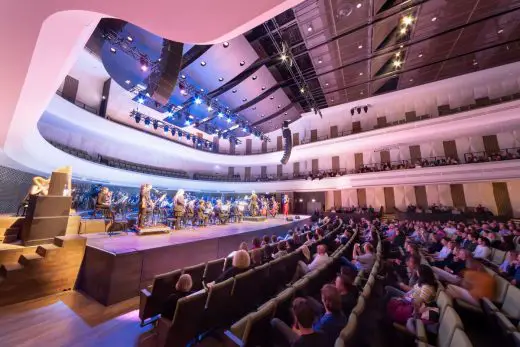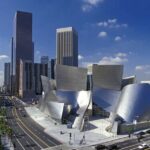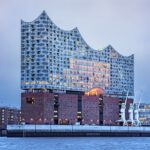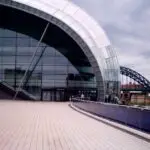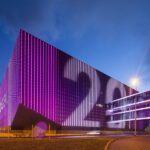Amare Den Haag design, The Hague building photos, Dutch City cultural venue, South Holland architecture
Amare Den Haag Building News
13 November 2022
Location: Spuiplein 150, 2511 DG Den Haag, Netherlands
Design: NOAHH | Network Oriented Architecture with JCAU and NL Architects
Home for the Amare Foundation, the Nederlands Dans Theater, the Residentie Orkest, and the Royal Conservatoire
Amare | huis voor cultuur, educatie, events en ontmoeting, Den Haag
Amare, The Hague – Home of the performing arts
Amare is a home for the performing arts, creative development, internationally excellent programming and conferences. This striking and idiosyncratic architectural eye-catcher was designed for the municipality of The Hague by NOAHH | Network Oriented Architecture, in collaboration with JCAU and NL Architects. A large part of Amare is accessible to the public and the building offers an unprecedented number of possibilities for the ways in which it can be used. It is now up to those who use it and residents of The Hague to make the building their own.
An eye-catcher with international allure
Amare is the new home for the Amare Foundation, the Nederlands Dans Theater (NDT), the Residentie Orkest, and the Royal Conservatoire. Amare is built on the site of the old Lucent Dance Theatre and the Dr. Anton Philips Hall.
Optimally integrated into the city’s urban plan, Amare is the soul of the cultural heart of The Hague, which also includes the Theater aan het Spui, the Filmhuis, the Nieuwe Kerk, the Public Library and the Atrium of the City Hall. It is the culmination of the Haagse Loper, the pedestrian boulevard that runs from central station to the Spuiplein. Amare is a cultural building with international allure, inviting for visitors and residents, a creative incubator for those who use it: an enrichment for The Hague.
Urban continuity
Amare has significant added value to the liveliness and versatile character of the city centre. It is a building where activities can take place 24/7. Even without a ticket you can pop into Amare for a cup of coffee, a yoga class or to visit the ‘market’ on the Arts Square or the children’s theatre at Park One.
The lower layers of the building form a fordable and welcoming passage through which everyone can move freely. There is no single formal entrance but rather a large entrance area with squares and streets.
Amare presents itself in every direction and can be perceived from any viewpoint: the old centre, the administrative centre, the business district, the residential area and the Rivierenbuurt. The countless connections with all these directions ensure that the environment is actively involved in the building. Recognisable from every angle, Amare is an urban ensemble that intensifies the experience of this place in The Hague and improves the adhesion between the city centre and surrounding neighbourhoods.
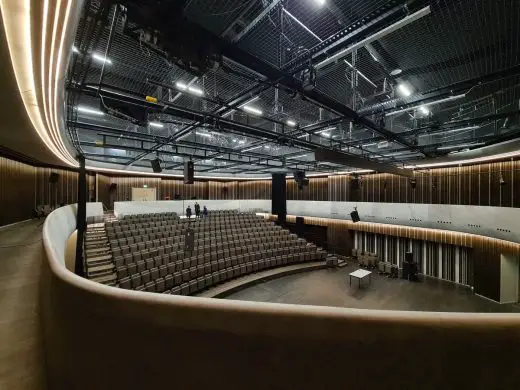
photograph © Jan Richard Kikkert
A city with large buildings and secret alleys
Amare is in fact a city, with streets, alleyways and squares nestled in-between large buildings. In addition to the large auditoriums, there are many smaller studios: beautiful spaces where you can not only practice, but also give a concert or performance. What is unique about Amare is that students and professionals co-exist in one building. On their way to their rehearsal rooms the students of the Royal Conservatoire pass the Concert Hall, the Amare Studio or the Dance Theatre. Here they can see the professionals of the Residentie Orkest or the Nederlands Dans Theater (NDT) practice or perform.
Amare brings users and visitors together in a variety of ways. Internal connections between the domains of the Royal Conservatoire, the Residentie Orkest and NDT enable spontaneous interactions. For example, the dancers of the NDT have their own Green Room from which they can watch the spectators as they stream in.
A graceful and compact building
The compact building has an understated yet confident design with an iconic, rhythmic facade. The natural continuity of the urban fabric has been achieved by opening the facade ‘like a series of theatre curtains’, with spacious passageways that are eight to ten metres wide. The tectonics, the ‘load bearing’, is manifested in the graceful, freestanding facade. Most of all the construction creates an elegant fabric that spans the building. The organically designed tree-branch structure is composed of prefabricated concrete elements. The vertical windows of the music studios and office spaces behind them run from floor to ceiling. As a result, there is good visual contact with the street and what is happening inside becomes visible outside.
Public interior
The interior has a successive series of meeting spaces that recur on the various levels in a series of characteristic foyers. The ground floor and the first floor are open to the public. Voids, stairs and escalators connect the public foyers with the four large halls that have been powerfully visually manifested in the interior.
Because the foyers are located along the facade on the Turfmarkt, they enliven the Haagse Loper in the evenings with large glass openings. The City Canteen on the third floor also plays an important role in the interior. Like a village square, this canteen connects the foyers and the different domains with one another. With its own, almost Mediterranean identity, this meeting space for artists, students and visitors forms the heart of the building.
World-class acoustics
Amare’s typology is based on the arrangement of large auditoriums alongside and over one another, surrounded by a ring of music studios and classrooms. The auditoriums are not stacked but placed next to each other with their own supporting structures and foundations, eliminating sound transmission. Amare has world class acoustics thanks to Federico Cruz Barney from Studio DAP Paris. The Dance Theatre’s anthracite-black interior references the old Lucent Dance Hall. The many movable wall panels provide excellent variable acoustics for dance, speech and opera.
The Concert Hall is predominantly classical in its design. The concrete wall finishes and gold-coloured sliding panels that regulate the acoustics are unique. The metal ceiling makes the auditorium very modern. The Conservatoire Hall is primarily made of concrete. Wooden slats and double curved concrete balustrades provide the right sound diffusion here. The Amare Studio, also the rehearsal room of the Residentie Orkest, is the most intimate room.
Identities
Amare accommodates different worlds in one building thanks to a rich variety of materials and colours. Each auditorium has a particular, recognisable exterior finish. For example, the finish of the Dance Theatre is made from bamboo, the Concert Hall is enveloped in a gold-coloured metal plate and the Conservatoire Hall is cloaked in raw concrete. Surrounding the auditoriums are foyers with a corresponding atmosphere: the foyers around the Concert Hall are characterised by Escher-like black steel stairs, gold-coloured metal wall cladding and white columns.
The Dance Theatre Foyer has a bamboo-wood shell that spans the entire height of the auditorium and columns clad in reflective black glass. Club 4, the foyer for the Conservatoire has a black steel interior and bar that matches the Conservatoire Hall’s brutal concrete facade with black steel entrance portals.
Every user has their own domain: a space with its own identity. By placing the domains close to one another, creative synergy is generated. The interaction between domains and floors is enhanced by the presence of voids and patios. The building offers a lot of space and undefined ‘in-between spaces’ that the users and artists can appropriate for themselves.
Paragon of sustainability
Sustainability demands not only a high-quality building for today, but also for the future. Amare has great flexibility to accommodate future developments. Because load-bearing inner walls have been avoided, the floor areas can be freely redetermined. Changes can be made without the need for structural interventions. Amare has been awarded a BREEAM Excellent certificate, whereby sustainable energy and technology is just as important as satisfaction, quality and user-friendliness. The roof is fully equipped with solar panels.
The reuse of the existing underground parking garages is also a special feature. In addition to its future value, and building on what was already there, Amare is an ‘inclusive building’: a building that is accessible to literally everyone, so much so that there are even birdhouses and bat roost tucked snuggly between the branches of the facades.
NOAHH | Network Oriented Architecture
The multidisciplinary architecture firm NOAHH | Network Oriented Architecture strives to create architecture that connects. NOAHH is fascinated by the interactions between buildings, environment and society and strives to design welcoming buildings that act as a platform for new typologies. The firm specialises in complex assignments with a social agenda, such as cultural, educational and public buildings. The MFC Doelum in Renkum (ARC18 Interior Award), the new Theater aan de Parade in ‘s-Hertogenbosch and TivoliVredenburg in Utrecht are good examples of this: innovative, public buildings that have a meaningful impact on their environment and its residents
www.noahh.nl
Amare Den Haag Concert Hall – Building Information
Amare – Home of the performing arts
Building information and capacity
GFA: 54,000 m2
of which c. 20,000 m2 for education: Royal Conservatoire
and c. 33,000 for culture; commercial c. 1000 m2
Address: Spuiplein 150, 2511 DG Den Haag
Capacities:
Concert Hall: 1500 seats or standing room for 2500
Dance Theatre:1300 seats
Conservatoire Hall: 600 seats
Amare Studio: 200 seats
Underground parking garages 700 cars and 1500 bicycles)
Completion year: 2021
Architect: NOAHH and JCAU in collaboration with NL Architects
Client: Municipality of The Hague
Building contractor: Bouwcombinatie Cadanz (Boele & van Eesteren | Visser & Smit Bouw)
MEP: HOMIJ Technische Installaties
Maintenance: VolkerWessels Vastgoedbeheer
Structural Engineer: Aronsohn raadgevende ingenieurs (Rotterdam)
Acoustic Advisor (auditoriums): Féderico Cruz Barney | Studio DAP (Parijs)
Installation consultant: Ingenieursburo Linssen (Amsterdam)
Technical consultant for theatre: Theateradvies BV (Amsterdam)
Building Physics and acoustics: LBP | Sight (Nieuwegein)
Sustainability advisor: LBP | Sight (Nieuwegein)
Interior design: NOAHH, JCAU, Brunnontwerp, Studio Aziz Bekkaoui
Contributing employees:
NOAHH Patrick Fransen, Stephanie Lama, Pieter Benschop, Aafke de Bode, Geert Mol, Ilse Bakker, Rimaan Aldujaili, Bilal Karaburun, Elisa Zampogna, Paul van Dijk (Studio Deep Blue), Dania Di Pietro, Serena Fanelli, Barbara Busslinger, Irina Margarit, Ashkan Hashemkhani, Magdalena Nalepa, Amaia Oyarbide, Onne Walsmit, Daan van Westen, Alexander van Nalta, Albert Laarman, Reijer Pielkenrood, Loes Thijssen, Ivo Brandes, Mick Madder, Paulina Kapczynska, Marielle Wetter, Kristina Kosic, Blaz Solar, Valeria Obino, Mirce Mladenov (Renderji), Ed Both (adviesbureau Both), Laura Nazzari, , Stella Makri, Maartje Nuy, Sebastiaan Boer, Eleonora Gaudini, Valentin Kobes, Paola Rapana, Anna Odulinska, Alma Holm.
Contributing employees:
JCAU Jo Coenen, Thomas Offermans, Laurens Cobben (LC Arch), Xenofon Moraitis, Luciënne Bregman, Willem Lucassen, Mark Haenen, Cas Bonnema, Eline Blom, Anne-Sophie Kortman, Guido Schot, Domenico Nava, Wouter Hagers, Yuri Buteijn, Paulos Kinfu, Cees van Giessen, Javier Pinazo, Jeroen Sprangers, Sada Shirafuji en Cristina Bestebreurtje
Contributing employees:
NL Architects Kamiel Klaasse, Pieter Bannenberg, Walter van Dijk, Gen Yamamoto, Sarah Moeller, Kirsten Huestig, Giulia Pastore, Ernesto Yélamos Quesada.
Amare Den Haag Concert Hall Building images / information from NOAHH | Network Oriented Architecture 121122
Phone: +31 70 880 0300
Location: Spuiplein 150, 2511 DG Den Haag, the Netherlands, western Europe
Architecture in Den Haag
Design: Studio Komma / The Men of Foam
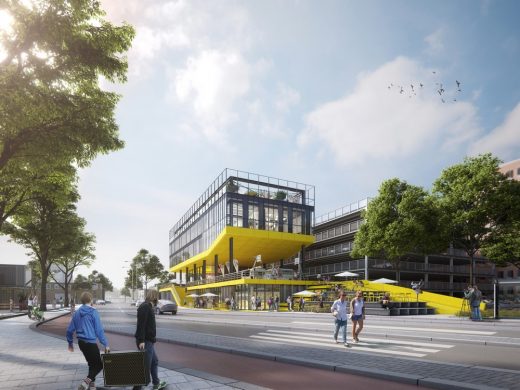
image © images Studio Komma / The Men of Foam
ZIP2516, Binckhorstlaan, Den Haag
Koekamp Visitor Center
Design: Powerhouse Company and DELVA
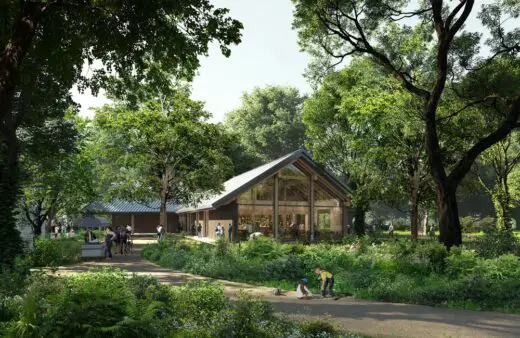
photo : Adrià Goula
Koekamp Visitor Center, The Hague
Inntel Hotels Den Haag Marina Beach, The Hague
Architects: KCAP
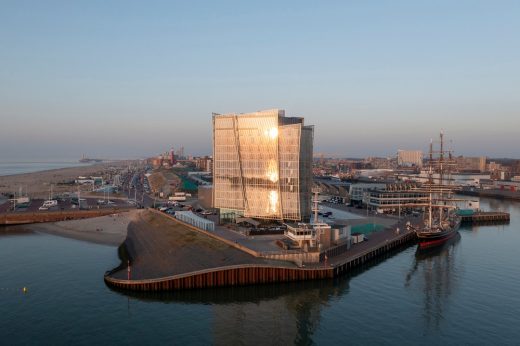
photo © Ossip van Duivenbode
Inntel Hotels Den Haag Marina Beach
Bicycle Parking Garage, under the Koningin Julianaplein
Design: Silo with Studio Marsman
Den Haag Bicycle Parking Garage
Design: cepezed Architects
Park Hoog Oostduin, The Hague
Architects: Mecanoo
Eurojust Den Haag
Design: Architekturbüro ZJA Zwarts & Jansma Architects / Knippers Helbig Advanced Engineering
Lightrailstation Den Haag
Dutch Architectural Designs
Netherlands Architecture Designs – chronological list
Contemporary Dutch Architectural Designs
Design: Powerhouse Company + De Zwarte Hond
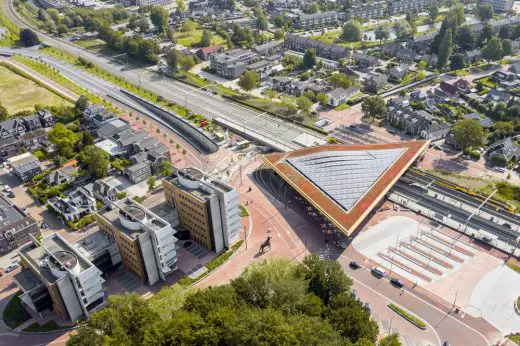
photo : Egbert de Boer
Assen Station Building
Architects: Denkkamer architectuur & onderzoek
KeenSystems HQ
Comments / photos for the Amare Den Haag Concert Hall Building design by NOAHH | Network Oriented Architecture page welcome

